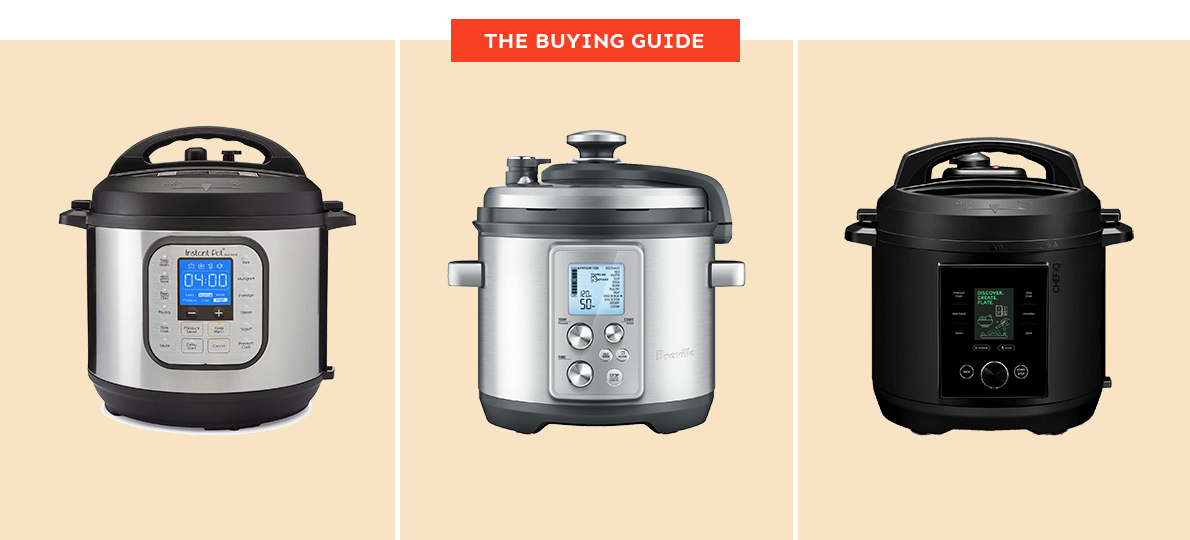
Pressure cookers have gotten more and more popularities and sales lately as a faster meal preparation tool. Unlike the old Grandma’s models, todays pressure cookers are obviously easier to use and safer to cook—no more exploding like rumors!
This ultimate buying guide will straightforwardly help choosing which pressure cookers are perfect for your needs, as well as give basic knowledge about how to use them properly. Note that: since being used in different objectives and foods, the pressure canners as excluded from this guide.
There’re tons of countertop appliance in the market that are designed to make a good day in the kitchen, but few are also versatile for culinary task, fast cooking, good for some certain ingredients and others. All-around, these’re grants that make these cookers worth the counterspace:
No fancy-schmancy thing, a pressure cooker is just a metal pot with a tight-fitting lid that seals that can help raising the boiling point of water. When closed properly and heated up, it will create an airtight seal that traps the steam and build pressure. Under pressure (up to 15 psi in stovetop models), the boiling point of water at 212°F at sea level can climb up to 250°F. This makes higher temperature and faster cooking.
There’re some scary rumors about exploding pressure cookers, which actually occurred in some old-schooled, low quality models. However, the modern versions, which have improved spring-valve regulator, are considerably safer, quieter and easier to us.
All pressure cookers can cook faster than conventional method. While electric versions—led by Instant Pot—are exceedingly popular these days, mostly from features and convenient reasons, they’re less powerful and durable, as well as lack of searing ability. On the other hand, stovetop models are sturdier, cook way faster and show more value in the long term.
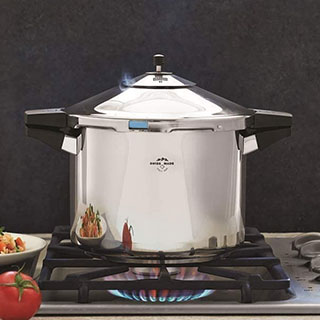
Fast & Powerful: Compare to electric, stovetop reach higher heat and pressure (15 psi compared to 11-12.5 psi, respectively). More pressure means a higher boiling point, so faster cooking times. This is also benefit for high-altitude dwellers, especially more than 3,000 feet.
3 Pressure Release Methods: Quick, normal (by open valve) and natural (do nothing).
Precise Control: Since you can control the heat just like a regular pot on the stove— raise and lower the heat to keep the right pressure level—you can try advanced techniques.
However, as manual regulating, it needs some experience to work well.
Better Sear & Brown: As cooking faster, it produces more Maillard reactions that makes brown and sauté more efficiently— thicker, darker and more complex flavor results.
Very Durable: Since it’s just a pot (or saucepan) with a sealed lid that made of stainless-steel or aluminum, it outlasts than electric tools—a good one can last for decades, which is worth for long time investment.
Also, the replacement parts are generally cheaper.
Alternative Pot: With the lid off or unsealed, it can be functioned as a pot to simmer soups, making stocks or sousing vide.
Various Size: Stovetop has different size and shape available—from a couple, a small family to crowd serving.

Set-and-Forget Operation: With electric, it’s no need to monitor or find the precise cooking time. Either press a pre-set or set the pressure and the time, let the machine do the work and then get tender results.
2 Pressure Release Methods: Quick (by open valve) and automatic.
Safe for Beginner and Elderly: No need to remember if the gas is on, when to adjust the heat or find to the way to release the pressure securely, it can automatically operate from the beginning to the end of process. Plus, it can be placed at any height safely.
Easy Pressure Release: No messing with knobs, timers or burns from hot steam, it has automatic pressure release when finishing.
All-in-One: As todays electric pressure cooker leans to a multi-cooker, it can do more duties than pressure cooking—such as rice cooking, slow cooking, steaming or even making yogurt. By just one machine, you can get rid of many kitchen tools for everyday culinary, so it’s good recommended for people who live in small space or lack of counter spaces.
Built-in Timer: When finishing, many models turns automatically to ‘Warm’ mode. This is a helpful function when you plan to eat late.
Every pressure cooker must have a method of controlling the pressuring process. For decades, the heat regulation has been improved. Say, the 30-year-old Granny’s pot totally differs from pressure cookers todays.
These are types for pressure regulators.
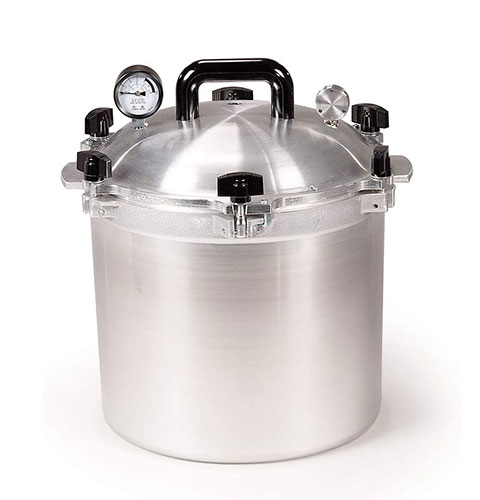
This old-fashioned method uses a weigh placing on the top of the vent tube to release excess steam during cooking. When pressure builds, it will force to lift the weight and release of steam, for regulating the temperature and pressure inside—and you’ll hear the jiggling (or a whistle) sound. This regulator will automatically release pressure for maintain 15 psi.
However, this regulator declines popularity nowadays for hard to monitor the temperature and maintain good pressure level, along with safety issues. It’s still found in canning pressure cookers.
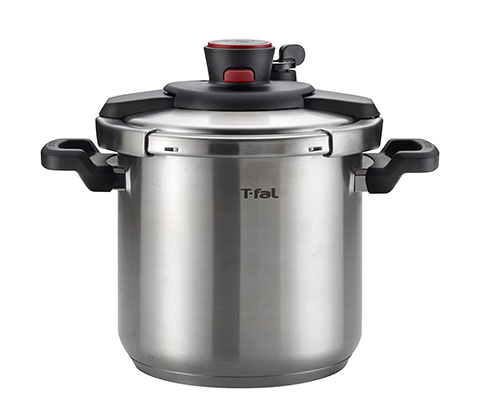
This modern regulator, sometimes called spring valve regulator, has spring-loaded release valves that will ‘pop up’ when pressuring. It has 2 pressure levels—High at 15 psi and Low at 10 psi—and allows for adjust the heat without venting steam. Without jiggling sound, it’s much quieter and requires monitoring the signal at the lid to adjust the appropriate temperature of your stovetop to maintain pressure.
Most modern models in the market use this regulation—such as Fissler, Kuhn Rikon, Zavor and T-Fal—as are quieter, easier to use, and more versatile.
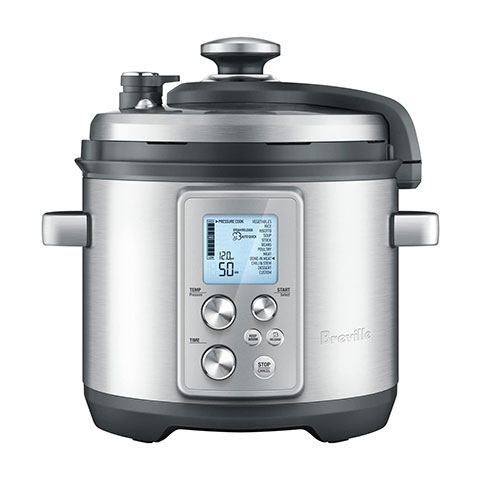
This type is found in electric pressure cookers. The appropriate pressure is completely automated and adjusted by the built-in thermostat controlling the temperature of inside the pot to be within a safe range, based on the type of food being cooked.
The regulator of each product is different in detail and makes different pressure levels. Instant Pot, for example, has the patented pressure sensor mechanism to keep pressurizing between 10.12 to 11.6 psi.
Some models, such as Breville Fast-Slow Pro, has dual sensors for more precisely temperature control.
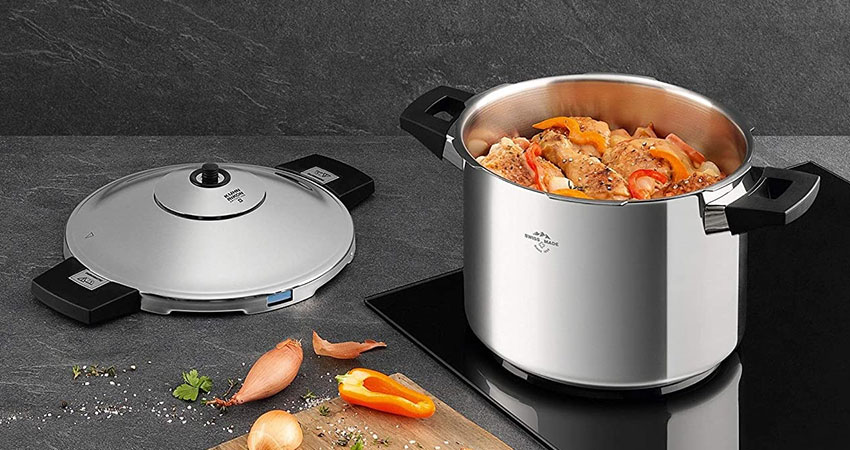
Sometimes, it’s confused to find the right size of some pressure cookers since the capacity labeled on the product doesn’t mean the real capacity to cook. Unlike the stockpot or even slow cooker, pressure cooker should not be filled to its maximum capacity to leave room for building pressure and foams and prevent food to block the pressure valve and other safety features.
For most foods, it should only be filled maximum 2/3 full while 1/2 full for grains and beans as these foods expand and foam during cooking. Many user-friendly models come with these fill lines, which make handy to use.
Laura Pazzaglia from Hip Pressure Cooker, suggested her helpful rule of thumb to calculate, “1 quart/liter per person in the household”—a 6-quart size will feed maximum 6 people. See more samples in the table.
| Size of pot | Dry Rice | Dry Bean | Soup |
| 2 | 1⅓ | ¾ | 5¼ |
| 4 | 2¾ | 1½ | 10½ |
| 6 | 4 | 2½ | 15¾ |
| 8 | 5½ | 3¼ | 21 |
| 10 | 7 | 4 | 26¼ |
| 12 | 8⅓ | 5 | 31⅔ |
Remember, the bigger isn’t better. If you only cook for a couple serve without leftovers, small size cooker will be better—save your budget, time and storage. In easier way, check this quick guideline for choosing the right capacity.
| Size of pot | People |
| 1½ | 1 - 2 |
| 3 | 3 - 4 |
| 5 | 5 - 7 |
| 7 | 7 - 10 |
| 10 | 10 - 15 |
The 6- to 8- quart sizes are common for universal tasks—from making stock, braising ribs to roasting a chicken. So, these are standard sizes found in electric cookers.
For some people, cooking with pressure can be a nerve-shaking mission. To eliminate most of the guesswork, be sure to choose products that has enough safety features In at least, both electric and stovetop pressure cookers should have these safety features:
Comparing to stovetop models, since most modern electric models offer many suitable features, they can help you get rid of many risky issues and easier to consider. To get a good pressure cooker, here is a basic rundown to check before buying.
Stovetop
Stovetop pressure cookers offer extremely wide range of prices—$30 to $300 for a 6-quart size—mostly diverging by type of regulator, material and craft. The spring valve type are more expensive than jiggle top.
Since they’re naturally a plain metal pot with reliable safety mechanisms, buying the high-priced products quite means the worthy investment than splurge—you’ll get more quality and safer tools that last for long, maybe a decade or more.
Electric
Commonly, a decent 6- to 8-quart electric model (with 2 pressure levels) can be found at around $70 to $250. Unlike stovetop version, the price of this pot tends to reflect the features as expected to be a multicooker. For example, an extraordinary-priced product like Ninja Foodi 9-in-1 costs around $400 for the multi-duties and air fryer function. Also, electric pressure cookers have less value than stovetop ones for shorter lifespan and more expensive parts.
For value-buying, buying ones that includes the features you’ll use. For example, if you’re not interested in air frying or making yogurt, pick the Instant Pot Duo instead of the Air Fryer model to save about $80*. Again, check the replacement parts if they have reasonable cost and is easy to find.